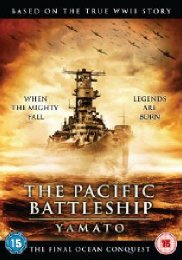The Pacific Battleship Yamato
The Pacific Battleship Yamato
July 31st 1945 saw the fall of the symbol of Japanese Imperial Naval power when the battleship Yamato was sunk in battle with US fighter bombers. Lying 325m below the surface at Latitude N 30.43 Longitude E 128.04, the 263m long wreck has been visited twice by marine exploration surveys. The Yamato, head of the Yamato class of battleships, was one of the largest battleships of the day, reaching a height of 51m (or the equivalent of an 18 storey building) and managing to displace 72, 800 tons. The Yamato class, commissioned in 1941, was originally designed to offset the numerical superiority of the US Pacific Fleet but hadn't learnt the lessons of the European Dreadnought class. Despite this, respect for the Yamato was so high that the Japanese believed that Japan would never fall whilst the Yamato was afloat.
This Japanese film about the Yamato focuses on the final days of the Second World War, but is framed around a modern story meant to be part of the 60th Anniversary of the sinking of the Yamato. After visiting the Yamato museum in Kure, Hiroshima, a young woman called Makiko Uchida (Koyoka Suzuki) is having little luck in finding a boat to take her to the site where the Yamato lies. Old boatman Katsumi Kamio (Tatsuya Nakadai), a survivor of the Yamato, agrees to take her but only after learning that she is the adopted daughter of his old crewmate PO Mamoru Uchida (Shido Nakamura). Everyone's reluctance isn't too surprising as the journey to the site will take around 15 hours, not an easy journey in the small fishing boats that Kure is home to. Still, Kamio owes a debt of honour to Uchida (who he believed had died on the Yamato) and to pass the time on the way to the site of the sinking, recalls his memories of his time on the Yamato with Uchida and shares them with Makiko.
The main film begins just prior to the battle of Leyte Gulf and focuses on a young group of cadets who are posted to the Yamato, including Kamio. Life is harsh on the battleship for the new recruits as they are subjected to some rather harsh training methods under three senior Petty Officers: Uchida, Moriwaki and Karaki, who have all served on the Yamato since 1941. Discipline is at the heart of training but as the recruits grow into their respective roles, so the relationships with the Petty Officers changes and becomes more paternal. The crew are first tested under fire during the Battle of Leyte Gulf in October 1944 with the Yamato sustaining damage from a number of bomb hits and Uchida loses his left eye. The Yamato is sent back to Japan to undergo repairs, a process that last well into early 1945.
In April 1945, the Yamato is essentially sacrificed in a vain attempt to prevent the downfall of Okinawa. Operation Ten-Go instructs the Yamato to head to Okinawa without any air cover and bombard Okinawa to prevent the Americans from gaining a foothold. The ship was then to run itself aground and continue firing whilst the rest of the crew would go ashore in support of the land effort. Disagreements break out in both the officer and junior ranks as belief is widespread in the futility of the mission, but this is quelled by the senior officers convincing all in the honour of their mission to defend their homeland. And so begins the last voyage of the Yamato...
The cinematography and production design for this film are superb, it's clear that a lot of time and money have been spent on this. There are numerous sets for various sections of the battleship, but you never feel that they are separate pieces. The battleship itself is clearly a CGI model but again feels whole. The scenes showing the ship under attack from aircraft are also well done but suffer slightly from seemingly showing the same camera angles. It's not enough to spoil it though. It's worth knowing that 600 million yen (approx. £4.5 million) was spent on building the scale sets of both the forward section and portside anti-aircraft guns, and this set was opened to the general public between July 2005 and May 2006.
Yamato the film also grossed a record 5.11 billion yen at the domestic box office, the Japanese audience clearly identifying with its concepts of honour and duty. I have to say that I really enjoyed this film, even with its few drawbacks. The soundtrack is Japanese with English subtitles, which is fine as this is the best way to watch foreign language films, but the Japanese actors have a tendency to overact now and again and yell at each other to make a point and pull rather bizarre grimaces in an attempt to show emotion. In reality it may well be part of the Japanese culture rather than acting, but it does get a bit grating at times. What may also grate some Western viewers is that there is no tone of regret or responsibility for the war actions of the Japanese, the characters are all willing to die in what they see as a righteous war. I personally don't see anything wrong with this though, as it's a simple retelling of events from a different angle rather than a post mortem on the Second World War. The director has also included actual WWII footage where appropriate to either highlight related events or to add real context to the story.
This is a long film, just shy of two and a half hours, but a rather good one and one that highlights a major event in Japanese history. It's not as good as Letters From Iwo Jima, but is still very good and worth the effort if interested in seeing war from the perspective of the other side...

































Your Opinions and Comments
Be the first to post a comment!